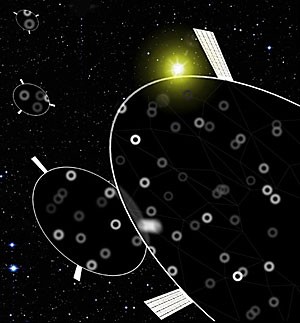Imagine more brilliant sunsets, a grayish white sky and trillions of spacecrafts drifting a million miles away between the Earth and the sun, and you have the results of a plan to correct global warming.
Roger Angel, director of the Steward Observatory Mirror Laboratory and the Center for Astronomical Adaptive Optics, has worked on a project to correct global warming – a project that he compares to turning down the sun’s energy with a light bulb dimmer switch.
The project Angel has been working on for about a year is a space sunshade that would deviate the angle of the sun’s rays and dim the amount of sunlight the earth receives by 2 percent.
Should there be an immediate global warming emergency when the amount of carbon dioxide in the atmosphere increased to twice its current level, the sunshade’s effect of reducing sunlight would balance the heating perpetuated by the greenhouse gases, Angel said.
“”Basically, it’s one knob that turns down the sun’s flux. The sky will stay blue and will produce brilliant sunsets,”” Angel said. “”You wouldn’t even notice that the sun was dimmed by 2 percent, it’s like the thinnest cloud in the sky.””
The “”cloud”” of sunshades would be 60,000 miles long.
Angel worked with a group in Siberia that makes the optics for the mirror lab to develop the sunshades, which are 2-foot-wide spacecrafts made of thin, transparent glass that is only a micron thick. Each sunshade will weigh only 1 gram, the weight of a butterfly.
At first glance, the screen looks like a roughed-up surface, but Angel demonstrated that by shining a laser pointer through the screen’s surface, the energy is scattered and instead of one constant beam, the laser is dispersed and the light emitted is less concentrated.
The sunshade’s surface would be imprinted on the micron-thick glass, completing the shade.
Along with the glass and surface, the sunshade will also have a solar sail that would reflect sunlight. By tipping the sail, scientists could control the sunshade should it drift off-course, Angel said.
The sunshade would be placed in a level of Earth’s orbit called L-1, or the “”sweet spot,”” as Angel calls it. This orbit is preferred because as the Earth goes around the sun, the “”sweet spot”” goes around at the same rate and anything in that orbit will stay indefinitely, Angel said.
The orbit is not completely stable, however, so any object will start to drift after a period of time, but Angel said the sunshade would have enough intelligence to keep itself in the right position.
Launching sunshades into space would be different than launching a rocket ship, because of how many sunshades are needed to deviate sunlight. The total mass of all the sunshades is 20 million tons, and a traditional rocket launch would cost several hundred trillion dollars, Angel said.
Nathan Stock, an astronomy graduate student, helped Angel research a new launch pad that would use electromagnets.
One of the big problems for the project is getting the total mass of all the sunshades into space, Stock said, so Angel came up with using electromagnetic force to propel the spacecraft up a two-kilometer launch tube.
The launch tube would have a series of electrical coils that propel the rocketuntil it accelerates to escape velocity, about 25,000 mph, the speed needed to escape Earth’s gravity.
But costs for building an electromagnetic launch pad and the velocity of traveling up the shaft are two obstacles in the sunshade project.
“”The startup costs prohibits the construction of a two-kilometer-high launch tube, and objects tend to disintegrate at that velocity by the time it reaches space,”” Stock said.
Astronauts are able to stand the high speeds because traditional rocket launches are gradual in reaching escape velocity, whereas the electromagnetic launch would be instantaneous, Stock said.
However, Angel said that different mechanical parts would be created to withstand the high-velocity force, and the cost of launching the sunshades would be $1 trillion.
The project is currently in a state of limbo because NASA has refused to fund any more work, Angel said.
“”I have communicated with the administrator of NASA, and he isn’t going to be funding anymore, but I’m not upset because my research is now on making affordable solar energy,”” Angel said.
Even though funding for the sunshade project has dried up, Angel is now focusing on ways to prevent global warming so the sunshade would never have to be used.
“”It’s something good to be looking into now,”” Stock said, “” but I hope it’s something we won’t ever use.””
Should global warming worsen, the sunshades would have to be in place for one to two centuries, which is the amount of time before carbon dioxide levels drop and heating stops.
Nick Woolf, a professor of astronomy working on astrobiology, has worked with Angel for 30 years and helped Angel present the sunshade project to the National Academy of Sciences.
“”Global warming is a serious problem, and I’m pleased to help Dr. Angel in any way,”” Woolf said.









